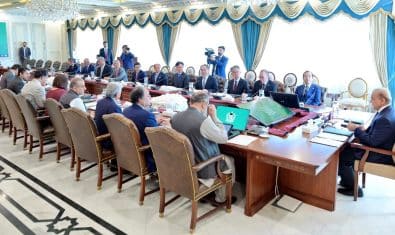After decades of electricity shortage and countless hours of load shedding across the country, now Pakistan has a new challenge – too much generation capacity.
Pakistan’s power supply ended up in surplus for the first time in 2020, after a flurry of coal- and natural gas-fired plants were built, primarily as a result of the Belt and Road Initiative project, reported Bloomberg.
By 2023, the power generation projections for Pakistan show as much as 50 percent surplus electricity as compared to the local demand, said Special Assistant to Prime Minister on Power Tabish Gauhar.
While it may seem like a good thing to have surplus production of electricity, the past trends of shortage in the country meant that the government needed to be the sole buyer of electricity. That continues to be the case even now, and the problem is that the government still has to pay producers even when they do not generate.
Now the government is in negotiations with the power producers to end that system, reduce their tariffs, and delay starting new projects, the SAPM said, adding that the government is also trying to convince industries operating on gas to switch to electricity. “We have a lot of expensive electricity, and that is a burden.”
ALSO READ
IPPs and Government Agree on Two-Installment Payment Plan
Another undeniable challenge that comes with excess production is the dilapidated transmission system, coupled with the need to maintain a cheaper supply while also controlling emissions.
Bloomberg report quoted Simon Nicholas, an analyst at the Institute for Energy Economics & Financial Analysis, saying, “Pakistan has overcapacity, yet it still has power shortages because of the unreliability of the grid. They haven’t invested in the grid the same way they’ve invested in power plants.”
The recent nationwide blackout is still fresh in the memory of the citizens of Pakistan, which happened just last month after an outage at the country’s largest facility. The power mix is also undergoing shifts, with new plants already taking coal generation to a record fifth of the power mix. Additionally, Pakistan is planning to increase the share of wind and solar to 30 percent, while another 30 percent will be generated from river-run dams.
ALSO READ
Pakistan Has Potential To Generate 150,000MW Energy From Wind Projects: PCJCCI
The new arrangements made by the government in this regard with power producers entail that the government will pay private power producers Rs. 450 billion ($2.8 billion) in overdue electricity bills in a deal to reduce future tariffs.
The government is aiming to pay 40 percent of that bill by the end of February, with the second payment scheduled before December, according to Gauhar.
A third of the payment will be made in cash, with the rest in fixed income instruments, he added.
The government aims to delay about 10 gigawatts worth of planned power projects, including coal and wind plants since there won’t be any need for them the next year, the SAPM informed.























AUR PAK THINK ABOUT EV : HYBIRD KO TO BARBAAD KAR DIA
AB EV PE KAAM KARENGE JAHA BIJLEE KI PRICE CONSTENT HE NAHI HAI
Bijli kay 100 Unit mai 600Km+ chalnay wali gari kahan sai mehngi hai?
Rs.24 ka unit bhi laga lai Rs.2400 mai bohot sasti hai.
Vast innovation is being in process in battery technology in future, Where Petro Diesel has no Significant life left because Petro/Diesel Engine only utilizes 30% Energy of its capacity. Whereas Electric Cars are more than 90% Efficient.
Thora Shaor paida kar, Har Cheez mai TAJZIA kar na hai tu, Tahqeeq kar k bola kar.
Wow… Apne kia zabardast jawab diya ha. Bilkul theek kaha, agar bijli ka unit 25 rupees ka bhi ho to 600km tab bhi sasta ha. Petrol se adhi price parhti ha. Petrol per 600km chalaney k liye kam az kam 5000 rupees ka petrol chahiye. Bal k ziada.
But why are we facing shutdowns these days????? And unannounced……
Simple Answer to your question is very difficult.
Generation is one of the 3 key components that make up every national electricity industry:
Step#1.Generation (making electricity)
Step#2.Transmission (moving electricity across high-voltage lines from generating plants to communities)
Step#3.Distribution (delivering electricity to individual customers)
According to the Pakistan Economic Survey 2019–20, the installed electricity generation capacity reached 37,402 MW in 2020.
The maximum total demand coming from residential and industrial estates stands at nearly 25,000 MW,
whereas the transmission and distribution capacity is stalled at approximately 22,000 MW.
This leads to a deficit of about 3,000 MW when the demand peaks.
This additional 3,000 MW required cannot be transmitted even though the peak demand of the
country is well below its installed capacity of 37,402 MW.
Remember Different types of Plants generating Electricity Fluctuate differently.So as demand.
Maintaining enough power in grid is very tough job.
In past we have only seen working on Generation, mostly high cost power plants and neglected work on Trasmission and Distribution.
In Future we will & should see work slowly and steadily on Trasmission and Distribution.
Planning of future is very important, As we are not very rich country and these two are also very costly steps now
We should see work slowly and steadily.
Transmission of Electricity is also very Costly. Hopefully within this year we see
Matiari to Lahore ±660kV HVDC Transmission Line Project
Which cost (US $2 Billion) to transmit 4000MW for 878km.
Distribution:
Like other problems this also is a Huge pain for DISCOS and Users.
Problem is we need to Understand that Goverment is already buying Electricity on very High Rates and providing
Electricity to Consumer by giving Subsidies and relief. We regularly Hear that Summary has sent to Prime Minister
for approval of increasing Electricity Tarrif by 10 11 Rupee and Prime Minister only increased 1 or 2 Rupee.
Increase of Electricity Price and Loadsheeding is because of Losses
And Major Losses Happen at Distrtibution Step.
Where People applying Kundas, Giving 5000 Rishwat to Meter Reader.etc
We need to understand if our Neighbour or someone is stealing Electricity, will effect and paid by Peolpe who already are
following Rules and areas with high losses also taste Blackouts in form of Loadsheeding.
In GB many potential sides are waiting in this matter. Need Govt. attention in field.
Its sad to see that previous governments to make personal gains opted for construction of generation plants only and that also at high costs, leading to expansive electric generation. Distribution sector was totally ignored.Problems created are being faced by ordinary people.
I think government should stop all capacity charges and allow free market economics. private companies should be allowed to produce , transmit and distribute electricity. Foreign fuel for electricity production should be banned.
nationalize these private operators OR throw them out
with 2.8 billion $ we can easily build a new grid